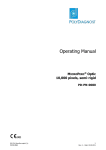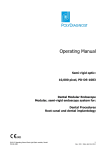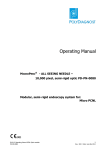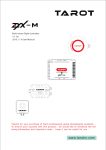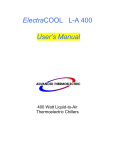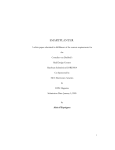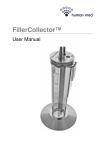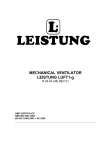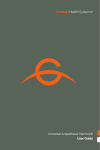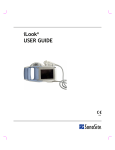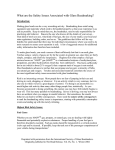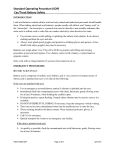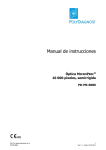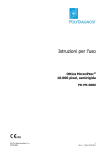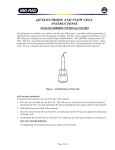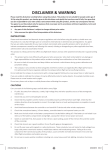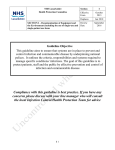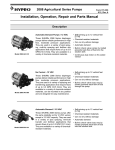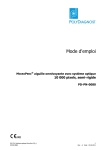Download User`s Manual - PolyDiagnost
Transcript
Operating Manual Semi-rigid optics: 3,000 pixel PD-DS-1086 6,000 pixel PD-DS-1084 10,000 pixel PD-DS-1083 30,000 pixel PD-DS-1080 0483 PD_IFU_Semi-rigid-optics-E_A PD-DS-1080, PD-DS-1083, PD-DS-1084, PD-DS-1086 1 Rev.: A Date: 19.03.2015 Table of Contents Page 1 Safety instructions.......................................................................................................... 4 1.1 Intended use ................................................................................................................. 4 1.2 Operating manual .......................................................................................................... 4 1.3 After receipt of the optic ................................................................................................. 4 1.4 Environment / Operation ................................................................................................ 4 1.5 Reconditioning and storage ............................................................................................. 5 1.6 Sterile packaged products ............................................................................................... 5 1.7 Compatibility and accessories .......................................................................................... 5 1.8 Compatibility.................................................................................................................. 5 1.9 Repair / Replacement ..................................................................................................... 5 2 Semi-rigid optic specifications ......................................................................................... 6 3 Product description ........................................................................................................ 7 3.1 Semi-rigid optic .............................................................................................................. 7 3.2 Overview of applications ................................................................................................. 8 3.3 POLYSHAFT® ................................................................................................................... 9 4 Functionality ................................................................................................................ 10 4.1 Assembly..................................................................................................................... 10 4.2 Instruments ................................................................................................................. 11 4.3 Connecting to the endoscopy video system .................................................................... 11 4.4 Checking the endoscopic image ..................................................................................... 11 5 Reconditioning ............................................................................................................. 12 5.1 General information...................................................................................................... 12 5.1.1 RKI guidelines.............................................................................................................. 12 5.1.2 Important information .................................................................................................. 12 5.1.3 Terminology ................................................................................................................ 12 5.1.4 Causes of faulty reconditioning ...................................................................................... 13 5.2 Cleaning, disinfection and sterilisation ............................................................................... 13 5.2.1 Notes .......................................................................................................................... 13 5.2.2 Precautionary measures................................................................................................ 14 5.2.3 Precleaning.................................................................................................................. 14 5.2.4 Manual cleaning and disinfection ................................................................................... 15 5.2.5. Machine cleaning and disinfection (disinfector) ............................................................... 16 5.2.6 Sterilisation ................................................................................................................. 18 5.2.7 Compatibility of materials.............................................................................................. 18 5.3 Storage of optic and accessories.................................................................................... 21 6 Troubleshooting ........................................................................................................... 21 6.1 Occurrence of a fault .................................................................................................... 21 PD_IFU_Semi-rigid-optics-E_A PD-DS-1080, PD-DS-1083, PD-DS-1084, PD-DS-1086 2 Rev.: A Date: 19.03.2015 7 Repair, Warranty, Disposal ............................................................................................ 22 7.1 Return for repair .......................................................................................................... 22 7.2 Warranty ..................................................................................................................... 22 7.3 Disposal ...................................................................................................................... 22 8 Transportation of the optic............................................................................................ 22 9 Classification................................................................................................................ 23 PD_IFU_Semi-rigid-optics-E_A PD-DS-1080, PD-DS-1083, PD-DS-1084, PD-DS-1086 3 Rev.: A Date: 19.03.2015 1 Safety instructions 1.1 Intended use The semi-rigid optic is provided for the endoscopic diagnosis and therapy of the milk duct, salivary duct, tear duct, temporamandibular joint and for arthroscopy of small joints. 1.2 Operating manual Before using the optic, thoroughly read the operating manual as well as the operating manuals of all other necessary devices that are used during the examination. Follow the instructions. All safety instructions must be complied with. Keep the operating manual in a safe, easily accessible place. The different endoscopic procedures and the medical aspects of endoscopy are not covered in this manual. A prerequisite for the safety of the patient is the correct handling of the endoscope by the doctor and medical personnel. The user must be trained on use of the device. 1.3 After receipt of the optic Check the optic for damage and operability. Do not use the optic if it has visible damage and / or its operability cannot be ensured. Contact your customer service representative if you notice unusual behaviour or irregularities. Damage during transportation must be reported immediately to the package service / transport company. WARNING: The optic was not sterilised or disinfected before it was delivered. It must be cleaned and disinfected / sterilised every time before use, as described in the corresponding chapter of the manual. 1.4 Environment / Operation Comply with the operating conditions of the endoscope as well as the conditions for storage and transport. The endoscope may become damaged or malfunction outside of the specified tolerances. Every time prior to use the optic and appropriate accessories must be examined for possible optical and mechanical damage in order to exclude risk of injury. Endoscopes with damage or defective components may no longer be used. During laser surgery and high-frequency surgery, comply with the instructions for use and the safety instructions of the used devices and accessories. When the endoscope is used in conjunction with electro-medical devices, make sure that the BF conditions (insulated, floating applied part) are complied with. Malfunction of a light source also used may cause hazards. Therefore keep an operable replacement light source available. PD_IFU_Semi-rigid-optics-E_A PD-DS-1080, PD-DS-1083, PD-DS-1084, PD-DS-1086 4 Rev.: A Date: 19.03.2015 1.5 Reconditioning and storage After use, recondition the optic and store it in accordance with general guidelines. Insufficient reconditioning may create an infection risk and cause damage to the device. ATTENTION: The optic is not autoclavable. Autoclaving can damage the optic. 1.6 Sterile packaged products Check that the sterile packaging of sterile packaged products is undamaged. Products may not be used when their packaging is damaged. 1.7 Compatibility and accessories Combination with devices that are not recommended may result in impairment to safety and performance. Use only the accessories specified for the optic. Use of incompatible accessories may cause malfunction and / or injuries to the user, patient and third parties. 1.8 Compatibility Our products may contain nickel and / or latex. Attention must be paid to corresponding allergies. In such cases, use of the device is at the discretion of the doctor. 1.9 Repair / Replacement Repair of defective devices may only be carried out by persons authorised by the manufacturer. Only original replacement parts may be used. Do not make any unauthorised modifications to the device and do not attempt to carry out a repair as this may cause damage to the device and therefore also pose a risk to patients and personnel. Unauthorised modifications or repairs release the manufacturer from any and all liability for the operational safety of the device. Unauthorised repairs carried out during the warranty period will result in cancellation of any form of warranty. ATTENTION: POLYDIAGNOST GmbH does not accept any responsibility for injuries and damage that result from improper use of the device and from non-compliance with this operating manual. Modification not carried out by POLYDIAGNOST GmbH or specialists authorised by POLYDIAGNOST will lead to loss of any claims under warranty. POLYDIAGNOST GmbH does not accept any liability for injuries or damage that occur after modifications that were not carried out by POLYDIAGNOST GmbH. PD_IFU_Semi-rigid-optics-E_A PD-DS-1080, PD-DS-1083, PD-DS-1084, PD-DS-1086 5 Rev.: A Date: 19.03.2015 2 Semi-rigid optic specifications 3,000 pixel optic, 70° 6,000 pixel optic, 70° Article number: PD-DS-1086 PD-DS-1084 Exterior diameter: 0.45 mm 0.55 mm Image control system: 3,000 pixels 6,000 pixels Viewing direction: 0°, direct view 0°, direct view Field of vision: 70° 70° Optic length: Standard light connection: 151 mm 151 mm ACMI adapter ACMI adapter Integrated fibre-optic lighting Integrated fibre-optic lighting Reinforced nitinol optic Reinforced nitinol optic Reusable optic Reusable optic 10,000 pixel optic, 120° 30,000 pixel optic, 70° Article number: PD-DS-1083 PD-DS-1080 Exterior diameter: 0.9 mm 1.3 mm Image control system: 10,000 pixels 30,000 pixels Viewing direction: 0°, direct view 0°, direct view Field of vision: 120° 70° Optic length: Standard light connection: 151 mm 151 mm ACMI adapter ACMI adapter Integrated fibre-optic lighting Integrated fibre-optic lighting Reinforced nitinol optic Reinforced nitinol optic Reusable optic Reusable optic Operating conditions Conditions for storage and transport Room temperature Rel. humidity Air pressure Temperature Rel. humidity Air pressure PD_IFU_Semi-rigid-optics-E_A PD-DS-1080, PD-DS-1083, PD-DS-1084, PD-DS-1086 + 15 °C to + 35 °C 30 % to 60 % 760 to 1060 mbar - 10 °C to + 45°C 10 % to 85 % 760 to 1060 mbar 6 Rev.: A Date: 19.03.2015 3 Product description 3.1 Semi-rigid optic 1) Optic 6 2) Shifter 1 3) Handle 5 4) POLYSHAFT® 4 5) Ocular 3 6) Optic protective tube 2 Figure 1 Figure 2: Shifter autoclavable 26 mm (PD-DS-1210), Figure 3: Shifter autoclavable 48 mm (PD-DS-1220), Figure 4: Medium-sized handle (PD-DS-1315) with irrigation and operating channel, autoclavable Figure 5: Short Figure 6: Fixed-focus Figure 7: Fixed-focus reusable ocular,black (PD-FS-4001), PD_IFU_Semi-rigid-optics-E_A PD-DS-1080, PD-DS-1083, PD-DS-1084, PD-DS-1086 handle (PD-DS-1320) with irrigation and operating channel, autoclavable reusable ocular,blue (PD-FS-4004), 7 Rev.: A Date: 19.03.2015 Figure 8: POLYSHAFT® 90mm (different diameters) for different applications, sterile, disposable Figure 9: POLYSHAFT® Figure 10: Trocar, Figure 11: Obturator, pointed (PD-DS-1185), autoclavable 3.2 50mm (different diameters) for different applications, sterile, disposable blunt (PD-DS-1195), autoclavable Overview of applications Optic Shifter 26 mm Shifter 48 mm Short handle Medium-sized handle Short handle PolyShaft 90 mm PolyShaft 50 mm PolyShaft 50 mm Application: Application: Application: Milk duct Temporamandibul ar joint Ophthalmology Salivary duct Arthroscopy Tear duct Arthrocentesis PD_IFU_Semi-rigid-optics-E_A PD-DS-1080, PD-DS-1083, PD-DS-1084, PD-DS-1086 8 Rev.: A Date: 19.03.2015 3.3 POLYSHAFT® 3,000 pixel optic 6,000 pixel optic 10,000 pixel optic Exterior dia.. Operating length Shape Milk duct 0.65 mm 90 mm straight PD-DS-1000 x Milk duct / Salivary duct 0.75 mm 90 mm straight PD-DS-1005 x x Milk duct / Salivary duct 0.9 mm 90 mm straight PD-DS-1010 x x Milk duct / Salivary duct 1.15 mm 90 mm straight PD-DS-1015 x Salivary duct 1.6 mm 90 mm straight PD-DS-1020 Salivary duct 2.0 mm 90 mm straight PD-DS-1025 Ophthalmology tear duct 0.75 mm 50 mm straight PD-DS-1030 x x Ophthalmology tear duct 0.9 mm 50 mm straight PD-DS-1035 x x Ophthalmology tear duct 1.1 mm 50 mm straight PD-DS-1038 x 1.6 mm 50 mm straight PD-DS-1042 x 1.3 mm 50 mm straight sharp pointed tip PD-DS-1065 x Application Temporamandibular joint arthroscopy Temporamandibular joint arthrocentesis D T D x x T D x x x x x x D = Diagnosis T = Therapy PD_IFU_Semi-rigid-optics-E_A PD-DS-1080, PD-DS-1083, PD-DS-1084, PD-DS-1086 30,000 pixel optic Article number 9 Rev.: A Date: 19.03.2015 x T D x x x x x x x x T x 4 Functionality Figure 12 4.1 Assembly Figure 14: Insert Figure 13: Slide shifter with open screw into port of the handle and connect to shifter with LuerLock onto optic into POLYSHAFT®, connect handle and POLYSHAFT® Figure 15: Insert Figure 16: Adjust optic exactly to the distal end of the POLYSHAFT®, secure shifter screw. Figure 17: Join ocular to body and connect to camera. PD_IFU_Semi-rigid-optics-E_A PD-DS-1080, PD-DS-1083, PD-DS-1084, PD-DS-1086 10 Rev.: A Date: 19.03.2015 4.2 Instruments Instruments can be inserted through the operating channel of the handle. The diameters must be matched to the optic and the POLYSHAFT®. ATTENTION: Instruments that can be opened or closed must always be closed when they are inserted into or pulled out of the operating channel. Insertion and / or use of accessories/instruments without a clear endoscopic view may cause injuries to the patient. Forced insertion of instruments into the operating channel can damage the endoscope. ATTENTION when laser devices are used: When laser devices are used the optic must be protected from the effects of the laser. The laser output power must only be activated when the tip of the laser fibre can be seen through the endoscope in order to prevent burns and/or unwanted penetrations in the tissue surrounding the optic. To prevent potential damage to eyes, suitable protection must be worn when laser devices are used. 4.3 Connecting to the endoscopy video system Connect the endoscope to the endoscopy video system with the ocular. Connect the fibre-optic cable to the endoscope. 4.4 Checking the endoscopic image After you have switched on the endoscopy video system, switch the light source to maximum intensity. Hold the distal end of the semi-rigid optic approx. 1 cm above a white surface and adjust the white balance with the corresponding switch. Then hold the distal end of the optic at the same distance above a "colourful graphic" and adjust the focus by turning the adjusting ring on the TV adapter. At the same time check the colour fidelity. Note: The image quality depends to a great extent on an optimum illumination output. To ensure this, the light-transition points of the endoscope and optical fibre must always be kept clean. PD_IFU_Semi-rigid-optics-E_A PD-DS-1080, PD-DS-1083, PD-DS-1084, PD-DS-1086 11 Rev.: A Date: 19.03.2015 5 Reconditioning 5.1 General information 5.1.1 RKI guidelines The Robert Koch Institut (RKI) has published guidelines for the preparation of used medical products. An overview of the required preparation steps: Proper preparation (collection, disassembly as required, pretreatment and precleaning) of the used medical products and their transport to the location of preparation, safely enclosed and in a way that avoids damage. Cleaning, disinfection, irrigation and drying. Check for cleanliness and sound condition of surfaces. Care and maintenance. Verification of technical/functional safety. Labelling. Packaging and sterilisation. Storage. 5.1.2 Important information All persons responsible for the reconditioning must be well trained in: - The reconditioning processes that are used Health and safety regulations National and local hospital guidelines The operating manual Function of endoscopy equipment Labelling of disinfectants 5.1.3 Terminology Microorganisms Bacteria, yeasts, fungi and viruses Microorganisms may not be found on surgical instruments and endoscopes (risk of infection) Cleaning Physical/chemical elimination of impurities (including organic substances) Disinfection Reduction of the number of microorganisms with the objective that as few as possible viable microorganisms survive (low-germ product) Sterilisation Reduction of the number of microorganisms with the objective that no viable microorganisms survive (sterile product) Sterile Absence of viable microorganisms (very high safety; less than one microorganism may survive on one million products) PD_IFU_Semi-rigid-optics-E_A PD-DS-1080, PD-DS-1083, PD-DS-1084, PD-DS-1086 12 Rev.: A Date: 19.03.2015 5.1.4 Causes of faulty reconditioning Shortening or termination of the reconditioning process Non-compliance with mandatory prescribed concentrations and application times Use of unsuitable chemicals Incompatible cleaning and disinfection solution Misjudgement of the consequences that may occur as the result of improper reconditioning Insufficiently reconditioned and prepared devices and/or cleaning, disinfection solutions (adhere to product lifetimes!) 5.2 Cleaning, disinfection and sterilisation 5.2.1 Notes Effective precleaning, cleaning and disinfection are a mandatory prerequisite for effective sterilisation of the optic and accessories. Make sure that the solution fully wets all surfaces, including any operating channels or cavities that may be present. Comply with the instructions of the manufacturer of the cleaning agent and disinfectant with regard to concentration and working time. Be aware of the compatibility of the used solutions with each other and comply with manufacturer specifications, e.g. with regard to concentration and application times. Make sure that only adequately validated device-specific and product-specific procedures are used for cleaning, disinfection and sterilisation, and that the validated parameters are complied with in every cycle. The carrying out of the preparation processes lies in the responsibility of the user with regard to attainment of the desired disinfection, cleaning and sterilisation effect. Additionally, comply with the regulations of the hospital and of the manufacturer of the cleaning agent and disinfectant, disinfectors and sterilisers, as well as the legal provisions applicable in your country. WARNING: The optic was not sterilised or disinfected before it was delivered. It must be cleaned and disinfected / sterilised every time before use. PD_IFU_Semi-rigid-optics-E_A PD-DS-1080, PD-DS-1083, PD-DS-1084, PD-DS-1086 13 Rev.: A Date: 19.03.2015 5.2.2 Precautionary measures ATTENTION The safety of the patient / personnel may be endangered when the devices and corresponding accessories are not properly cleaned and disinfected / sterilised. When cleaning is not carried out, this endangers the effectiveness of disinfection / sterilisation. Devices and accessories must be cleaned as thoroughly as possible before disinfection. Thorough cleaning reduces the number of microorganisms present, eliminates organic materials and therefore supports the effectiveness of the disinfection/sterilisation procedure. Contact with secretions from the patient and reconditioning chemicals may endanger your health. During reconditioning therefore, always wear the prescribed protective equipment as specified in hospital or national regulations. Suitable protective equipment are: protective goggles, face mask, moisture-resistant protective clothing or lab coats (note: soiled lab coats must be taken off before leaving the reconditioning area), chemicalresistant, water-proof gloves that fit well and are sufficiently long. Gloves must be exchanged and disposed of at regular intervals. Make sure that the reconditioning area is sufficiently ventilated as specified in the hospital or national health and safety regulations. Sufficient ventilation (at least eight to ten air changes per hour) reduces chemical vapours. Irrigate the channels thoroughly and carefully. To be free of disinfectants, all internal channels must be thoroughly irrigated with sterile water. When drying or irrigated channels with air or liquid, do not use a pressure greater than 50 kPa, otherwise the channels may be damaged. 5.2.3 Precleaning Precleaning must be carried out immediately after the examination. This prevents blood, protein or other substances from drying out. - Loosen/remove all instruments, valves, caps and accessories from the optic. Dispose of all disposable products. Loosen the handle and shifter from the optic. Irrigate internal channels of the accessories with disinfectant. Carefully clean the lens (distal end) of the optic by lightly rubbing it with adamp swap. Place the optic protection tube onto the optic. Then irrigate with disinfection solution, see Figure 18. Figure 18 PD_IFU_Semi-rigid-optics-E_A PD-DS-1080, PD-DS-1083, PD-DS-1084, PD-DS-1086 14 Rev.: A Date: 19.03.2015 Note: The disinfectant used must be approved by the manufacturer for disinfection of endoscopes. Use cleaning-friendly instrument trays for the endoscopes. Avoid impacts and contact with other instruments. Finally, tap water or sterile water must be used for sufficient rinsing. Cleaning and disinfection must be carried out immediately after use and precleaning. This can be done with machine procedures (disinfector) or manual procedures (insertion in cleaning agent and disinfectant). 5.2.4 Manual cleaning and disinfection Important: Ensure that the effectiveness of the cleaning agents and disinfectants has been verified. That the cleaning agents are compatible with the used disinfectants. The used agents are approved by the manufacturer for cleaning and disinfection of endoscopes. The concentrations and application times specified by the manufacturer of the cleaning agent or disinfectant must be complied with. Use only sterile water for irrigation after disinfection. Only freshly produced cleaning, disinfection and irrigation solutions may be used, they may only be used once. Sharp objects may not be used for handling optical surfaces. In general, endoscopes must be handled with great care during cleaning/disinfection to avoid damage from application of excessive force, knocks, bending or being dropped. Do not use brushes or metal sponges for cleaning the surfaces and internal channels as they may cause damage. The semi-rigid optic, endoscopy accessories and other parts may not be inserted in physiological saline solution and may also not be cleaned in an ultrasonic bath. Damage to the endoscope and its accessories is the consequence of both processes. Cleaning: 1. Fill a basin with fresh cleaning solution. 2. Immerse the optic with fitted protective tube (Figure 19) and the accessories into the cleaning solution, the optic / accessories must be completely submerged. Figure 19 PD_IFU_Semi-rigid-optics-E_A PD-DS-1080, PD-DS-1083, PD-DS-1084, PD-DS-1086 15 Rev.: A Date: 19.03.2015 3. Clean the exterior surfaces with a soft cloth or sponge. 4. Clean internal channels of the accessories in the cleaning basin by using suitable cleaning brushes. Always brush from the proximal end to the distal end. 5. Make sure that the cleaning solution does not foam too much (reduced cleaning effectiveness). 6. Irrigate the optic thoroughly with cleaning solution at least five times (disposable syringe), see Figure 40. 7. Also irrigate the accessories thoroughly with cleaning solution at least five times. 8. Remove the optic and accessories from the cleaning bath no earlier than after the application time recommended by the manufacturer of the cleaning agent. 9. Afterwards irrigate all devices and accessories with sterile water at least five times (disposable syringe). Length of the irrigation cycle at least 1 minute. 10. Finally dry all internal channels by blowing through with medically pure compressed air. Disinfection: 1. Fill a basin with disinfection solution. 2. Immerse the optic with fitted protective tube and the accessories into the disinfection solution, the optic / accessories must be completely submerged. 3. Disinfect the exterior surfaces with a soft cloth or sponge. 4. Irrigate the optic thoroughly with disinfection solution at least five times (disposable syringe), see Figure 40. 5. Also irrigate the accessories thoroughly with disinfection solution at least five times. 6. Remove the optic and accessories from the disinfection bath no earlier than after the application time recommended by the manufacturer of the disinfection solution. 7. Afterwards irrigate all devices and accessories with sterile water at least five times (disposable syringe). Length of the irrigation cycle at least 1 minute. 8. Finally dry all internal channels by blowing through with medically pure compressed air. Dirt particles on optical surfaces can be post-treated and removed with a swab soaked in alcohol (70 % ethanol) or with a neutral cleaner. The fundamental suitability of the POLYDIAGNOST endoscopy devices for effective manual cleaning and disinfection has been verified by an independent testing laboratory by using the cleaning agent CIDEZYME1 (application concentration 1.6 %, application time 5 min) and the disinfectant CIDEX1 (undiluted, activated solution, application time 30 min). The process described above was incorporated for this. 1 Johnson & Johnson Medical GmbH, Norderstedt 5.2.5. Machine cleaning and disinfection (disinfector) Important: Ensure that the effectiveness of the device has been verified. The device has corresponding connections for the operation and irrigation channels. That the cleaning agents are compatible with the used disinfectants. The used agents are approved by the manufacturer for cleaning and disinfection of endoscopes. Make sure that the appropriate program is selected for thermolabile products. Excessive irrigation pressure is not used for the operation and irrigation channels (see 5.2.2 Precautionary measures: pressure not greater than 50 kPa). PD_IFU_Semi-rigid-optics-E_A PD-DS-1080, PD-DS-1083, PD-DS-1084, PD-DS-1086 16 Rev.: A Date: 19.03.2015 The program has sufficient irrigation cycles. When a thermal disinfector is used, note that the temperature of over 100°C reached during drying means that only endoscopes/devices labelled as being autoclavable may be disinfected. Cleaning programs selected for thermolabile endoscopes must not exceed a temperature of 60 °C. The concentrations and application times specified by the manufacturer of the cleaning agent or disinfectant must be complied with. Use only sterile water for irrigation after disinfection. Only freshly produced cleaning, disinfection and irrigation solutions may be used, they may only be used once. Note: According to RKI guidelines, endoscopes and endoscopy accessories must also be manually precleaned when machine cleaning and disinfection is used. Follow steps 1 to 10 in the "Cleaning" section in chapter "5.2.4 Manual cleaning and disinfection". Only after you have completed this, continue as follows: 1. Placed the disassembled endoscopy system into the disinfector by using the sterilisation tray. Make sure that the devices are not damaged by this. Sort instruments and accessories properly on machine-suitable instrument screens. 2. Connect the operation and irrigation channels to the connection tubes on the disinfection basket. 3. Select the endoscopy cleaning program corresponding to the load and which is recommended by the manufacturer. Start the program. 4. Remove the endoscopy system once the program has finished. 5. If necessary, let the endoscopy system dry out. Dirt particles on optical surfaces can be post-treated and removed with a swab soaked in alcohol (70 % ethanol) or with a neutral cleaner. The fundamental suitability of the POLYDIAGNOST endoscopy devices for effective machine cleaning and disinfection has been verified by an independent testing laboratory by using the disinfector Hamo LS-20001 (program no. 89, 50 °C), the cleaning agent Korsolex Endo-Cleaner2 (concentration 150 ml/30 l, application time 5 min) and the disinfectant Korsolex Endo-Disinfectant2 (concentration 300 ml/30 l, application time 10 min). The process described above was incorporated for this. 1 2 Hamo AG, Schweiz Bode Chemie GmbH, Hamburg After cleaning, disinfection, irrigation and drying: Check for cleanliness, sound condition of surfaces (e.g. corrosion, material quality, no sharp edges and dents) and patency of internal channels; possibly identification for the purpose of making a decision on repeated reconditioning preparation or disposal. Maintenance. Verification of technical/functional safety. PD_IFU_Semi-rigid-optics-E_A PD-DS-1080, PD-DS-1083, PD-DS-1084, PD-DS-1086 17 Rev.: A Date: 19.03.2015 5.2.6 Sterilisation Only previously cleaned, disinfected and completely dried endoscopes and accessories may be sterilised. The products must be placed in the sterilisation tray before sterilisation. Care must be taken that the products are not bent or damaged. The sterilisation tray must subsequently be packaged in suitable sterilisation packaging (disposable sterilisation packaging for the intended sterilisation procedure) according to DIN EN 868-2 or DIN EN ISO 11607-1. Retaining brackets are installed in POLYDIAGNOST original sterilisation trays that prevent mechanical damage to unfixed devices. Only the sterilisation procedures listed below are to be used for sterilisation, other sterilisation procedures are not permissible: Semi-rigid optic with protective tube in the sterilisation tray Handles, shifters X X X X X X ETO gas sterilisation (55 °C to max. 60 °C) Low-temperature plasma sterilisation: ® STERRAD 100S Steam sterilisation (autoclaving) 121 °C, 20 min (max. 124 °C) Steam sterilisation (autoclaving) 132 / 134 °C, 5 min (max. 137 °C) (X = permissible) Make sure that only adequately validated device-specific and product-specific procedures are used for sterilisation, and that the validated parameters are complied with in every cycle. Additionally, comply with the regulations of the hospital and of the manufacturer of the sterilisers, as well as the legal provisions applicable in your country. The principal suitability of endoscopes for effective ETO gas sterilisation has been provided by an independent testing laboratory by using the Sterivit procedure of DMB Apparatebau GmbH, Wiesbaden. The process stated above was incorporated for this. Note: The carrying out of all quoted sterilisation processes lies in the responsibility of the user with regard to attainment of the desired or required sterilisation effect. Use of different sterilisation processes in an alternating sequence may result in early ageing of endoscopes. If possible, use solely one of the authorised processes. 5.2.7 Compatibility of materials Due to constant technical advances in development, it can not be guaranteed that this list is complete. We recommend the tested and approved disinfectants (type 1) and cleaning agents (type 2) listed below: PD_IFU_Semi-rigid-optics-E_A PD-DS-1080, PD-DS-1083, PD-DS-1084, PD-DS-1086 18 Rev.: A Date: 19.03.2015 Manual cleaning and disinfection / sterilisation: Product name Manufacturer Type ® Advanced Sterilization Products c/o Johnson & Johnson Medical GmbH 2 Cidex OPA Advanced Sterilization Products c/o Johnson & Johnson Medical GmbH 1 ® Bode Chemie GmbH 1 ® Bode Chemie GmbH 1 ® Bode Chemie GmbH 1 Sekusept Extra N ® Ecolab GmbH 1, 2 ® Ecolab GmbH 1 ® Sekusept Plus Ecolab GmbH 1, 2 Instru Plus Laboratorium Dr. rer. nat. Deppe 1 Instru Star Laboratorium Dr. rer. nat. Deppe 1, 2 Instru Zym CIDEZYME ® Aseptisol Korsolex AF Korsolex Plus Sekusept Forte gigasept Laboratorium Dr. rer. nat. Deppe 2 ® Schülke & Mayr GmbH 1 ® Schülke & Mayr GmbH 1 gigasept FF Machine cleaning and disinfection / sterilisation: Product name Manufacturer Type BHT Scope Cleaner BHT Hygienetechnik GmbH 2 BHT Scope Desinfectant BHT Hygienetechnik GmbH 1 ® Bode Chemie GmbH 2 Korsolex Endo-Cleaner ® Bode Chemie GmbH 2 ® Bode Chemie GmbH 1 neodisher Septo DN ® Dr. Weigert GmbH & Co. KG 1 ® Dr. Weigert GmbH & Co. KG 1 Sekumatic FD Ecolab GmbH 1 Endomat Plus Laboratorium Dr. rer. nat. Deppe 1 3E-Zyme Medisafe UK, Ltd. 2 ® Schülke & Mayr GmbH 1 ® Schülke & Mayr GmbH 2 ® Schülke & Mayr GmbH 2 Dismoclean 24 Vario Korsolex Endo-Disinfectant neodisher Septo DA ® thermosept ED thermosept ER thermosept RKN-zym PD_IFU_Semi-rigid-optics-E_A PD-DS-1080, PD-DS-1083, PD-DS-1084, PD-DS-1086 19 Rev.: A Date: 19.03.2015 When choosing cleaning agents and disinfectants, please make sure that they do not contain the chemicals listed below: - Aromatic hydrocarbons - Hydroxylamine - Weak and strong mineral acids - Isobutanol - Weak and strong organic acids - Isopropanol - Oxidising acids - Iodine and iodine tincture - Strong alkalis - Iodine starch solution - Acetone - Potassium hydroxide solution - Ethanol - Potassium bifluoride - Ethyl acetate - Potassium hypochlorite - Ethyl glycol - Calcium hypochlorite - Battery acid 10% - Nitrohydrochloric acid - Formic acid - Copper(II) chloride - Long-chain alcohols from 3C atoms - Methanol - Aluminium chloride - Methyl chloride - Ammonium concentrates - Methyl ethyl ketone - Ammonium bifluoride - Mineral lubricants - Aniline hydrochloride - Monochloroacetic acid - Antimony chloride - Sodium hydroxide sol.(10%) and conc. - Benzine - Sodium hypochlorite - Benzoic acid - Nicotinic acid - Benzene - Nitrobenzene - Bromine - Perchlorethylene - Bromine water > 1% - Perchloric acid - Hydrogen bromide - Phenol solution - Butanol - Phosphoric acid (10%) - Chlorine - Mercury(II) chloride - Chlorinated lime - Nitric acid (10%) - Chloric acid - Hydrochloric acid (10%) - Chlorosulfonic acid - Sulphuric acid (10%) and conc. - Chloroform - Styrol - Chromic acid - Turpentine - Chromosulfuric acid - Hydrogen tetrachloride - Dimethylformamide - Toluene - Iron(III) chloride - Trichlorethane - Acetic acid 10% and conc. - Trichlorethylene - Hydrogen fluoride - Hydrogen peroxide (30%) - Hydrofluoric acid - Xylene - Formalin (30%) - Tin ammonium hexachloride - Glycol and glycolic acid - Citric acid PD_IFU_Semi-rigid-optics-E_A PD-DS-1080, PD-DS-1083, PD-DS-1084, PD-DS-1086 20 Rev.: A Date: 19.03.2015 5.3 Storage of optic and accessories - The storage space must be low-germ, low-dust, dry and well ventilated. Temperature fluctuations must be avoided. - Do not store the semi-rigid optic in the transport case. - Store the optic in the supplied protective tube and properly in the sterilisation tray or a suitable storage tray, the same applies for the accessories. This reduces the risk of damage. - Thoroughly dry all parts of the optic and the accessories before storing them. - The handle, shifter and accessories must be stored separately from the semi-rigid optic. - Storage in direct sunlight, at a high temperature or where they are affected by X-rays can damage the optic or accessories or pose an infection risk. 6 Troubleshooting 6.1 Occurrence of a fault Fault: No picture. Possible causes: - No or inadequate connection fibre-optic cable/endoscope or light source - Incorrect fibre-optic cable adapter - No or inadequate connection endoscope/ocular - Defective optic - Light source and/or camera and/or monitor defective - Configuration of monitor/camera incorrect - Mains power supply not connected or faulty Remedy: - Check the connections of the fibre-optic cable and ocular - Check the fibre-optic cable - Check the light source/camera/monitor - Check the monitor/camera configuration - Check the mains power supply - Return the optic Fault: Cloudy picture, stripes, streaks, etc. Possible causes: - Endoscope optical components are dirty - Defective optic Remedy: - Clean carefully with swab or suitable cloths soaked in alcohol (70% ethanol) - Return the optic Fault: High noise level due to light quantity being too low. Possible causes: - Endoscope optical components are dirty - Inadequate connection fibre-optic cable/endoscope or light source - Inadequate connection endoscope/ocular - Defective fibre-optic cable or defective optical fibre of the optic Remedy: - Clean carefully with cotton sticks or suitable cloths soaked in alcohol - Check the connections of the fibre-optic cable and ocular - Replace the fibre-optic cable - Return the optic When faults cannot be rectified by simple measures, please contact your technician or POLYDIAGNOST customer service representative. PD_IFU_Semi-rigid-optics-E_A PD-DS-1080, PD-DS-1083, PD-DS-1084, PD-DS-1086 21 Rev.: A Date: 19.03.2015 7 Repair, Warranty, Disposal 7.1 Return for repair Repair of defective devices may only be carried out by persons authorised by the manufacturer. Only original replacement parts may be used. Do not make any unauthorised modifications to the device and do not attempt to carry out a repair as this may cause damage to the device and therefore also pose a risk to patients and personnel. Unauthorised modifications or repairs release the manufacturer from any and all liability for the operability and operational safety of the device. Unauthorised repairs carried out during the warranty period will result in cancellation of any form of warranty. Important: A repair number must be requested from POLYDIAGNOST before returning the device. You can return the device for repair using this repair number. Please include a fault description and telephone number of the contact person with the shipment. Devices must be thoroughly cleaned and disinfected before they are returned for repair. Include written confirmation that this has been done. Insufficiently reconditioned devices represent an infection risk for all persons who come into contact with them. Contaminated devices will not be accepted by POLYDIAGNOST. 7.2 Warranty The warranty period is 12 months from the date of the invoice. 7.3 Disposal The device is to be disposed of at the end of its working life in accordance with local regulations. 8 Transportation of the optic Transportation or disposal of the optic may only be carried out when it is in a disinfected state. To reduce the risk of damage: Transport the optic properly in the sterilisation tray or a suitable storage tray, the same applies for the accessories. Or transport the optic in the transport case. Make sure that the optic is carefully placed in the correct recesses in the case and that the case is not closed if the optic cable protrudes over the edge of the case. ATTENTION: The transport case can not be cleaned or disinfected. Clean and disinfect or sterilise the optic before you place it in the transport case. Important: Please pay careful attention to the information below in the event of damage during transportation as the transportation insurance company is not obliged to make reimbursements if these formalities are not complied with. In the event of damage during transportation, it is in your interest to secure your claims for compensation by consulting representatives of the package service / transport company as early as possible for assessment of the damage in the context of their applicable regulations. PD_IFU_Semi-rigid-optics-E_A PD-DS-1080, PD-DS-1083, PD-DS-1084, PD-DS-1086 22 Rev.: A Date: 19.03.2015 This means that if a loss of or damage to the goods is apparent, the recipient must report the loss or damage to the shipper no later than when the goods are delivered. In the case of transportation by rail, a damage or loss report must also be requested from the rail company. In the case of parcel shipments, before damaged parcels are accepted the package service must certify in writing that the parcels are damaged. In the event of damage not immediately apparent , the package service or shipping company must be informed in writing immediately after the damage has been ascertained. Please also notify the dispatching department of our company quoting the number of the delivery note and invoice, and include these documents with your complaint. 9 Classification Classification: 0483 CE: This device satisfies the requirements of Council Directive 93/42/EEC as regards medical devices. This device is a Class IIa product. POLYDIAGNOST GmbH Am Söldnermoos 17 D – 85399 Hallbergmoos Phone: +49 (0)811 9987338-0 PD_IFU_Semi-rigid-optics-E_A PD-DS-1080, PD-DS-1083, PD-DS-1084, PD-DS-1086 23 Rev.: A Date: 19.03.2015























